The best folding bikes 2025: versatile, compact and lightweight models reviewed and rated
Ideal for commuters and those lacking space, we select our favourite folders and offer advice on how to find the right one for you
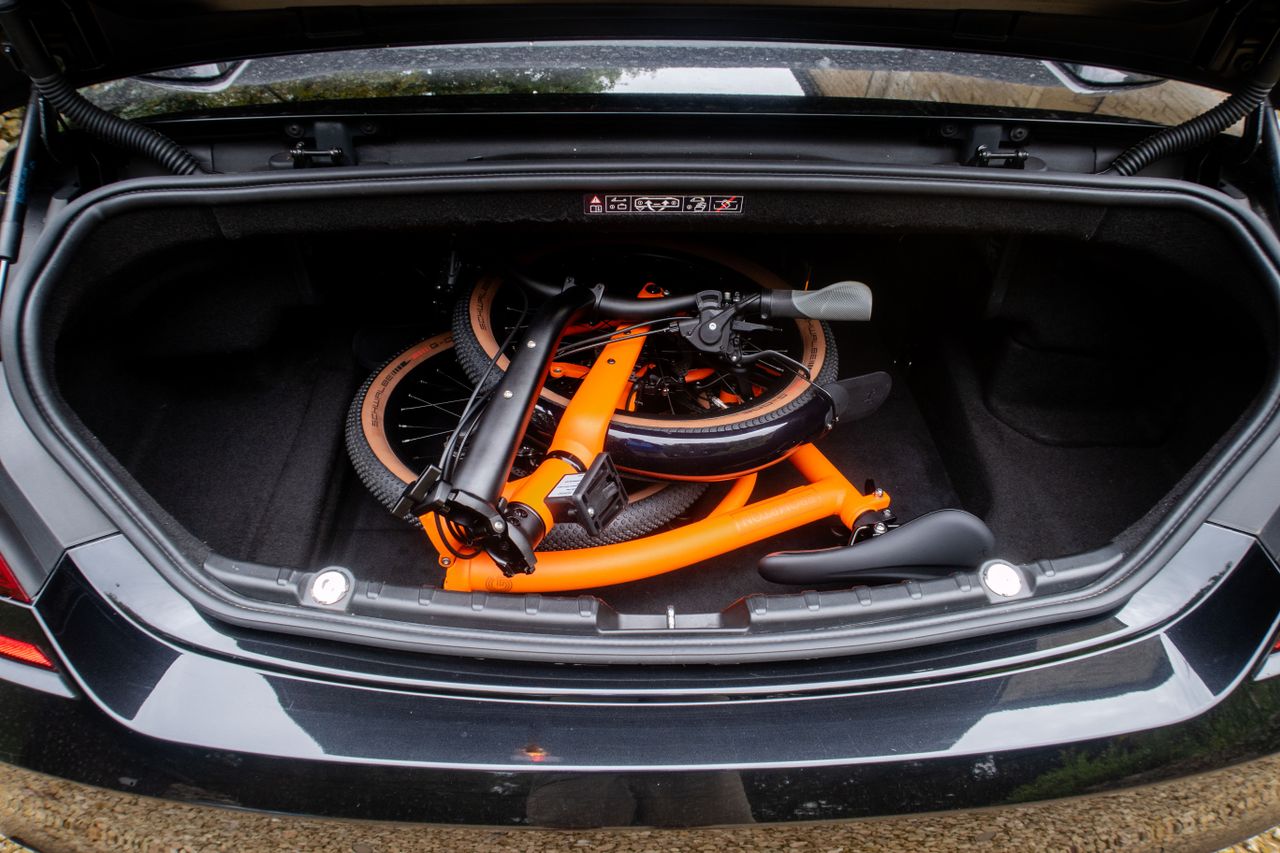
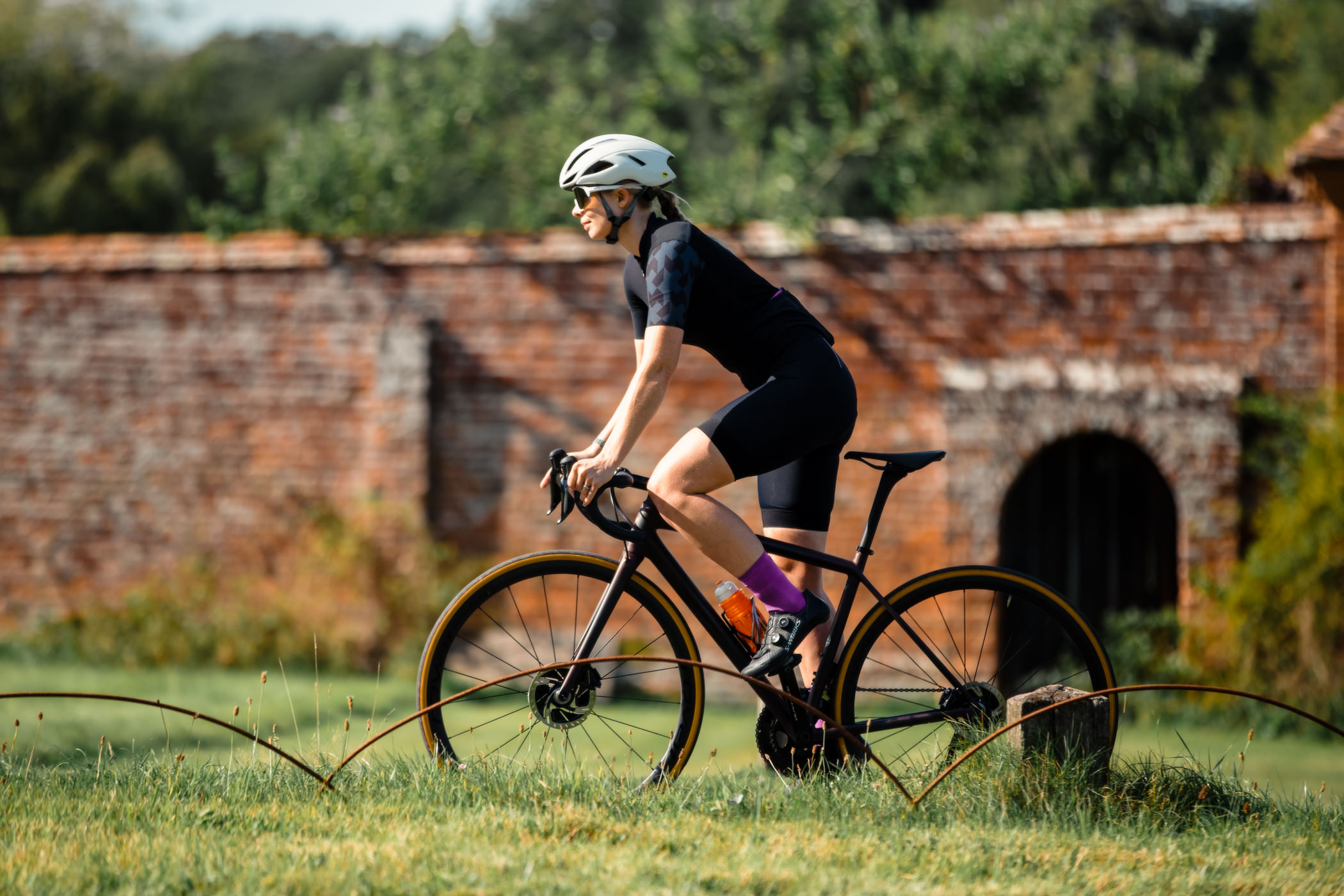
Having one of the best folding bikes in your arsenal can be a practical solution for anyone keen to mix up their commute and get fit or who is limited on storage. For commuters using different transport options to reach work, these bikes are a convenient alternative to traditional bicycles. They even allow you to take them on New York City buses or London Underground trains.
While some bikes offer off-road capability, like the Brompton G Line, Folding bikes are urban-centric and a great alternative to the best commuter bikes. However, the best folding bikes aren't limited to commuter duties; thanks to their convenience and size, they are increasingly popular with the RV and van life community and those looking for more sustainable transport options across the continent. Some even like to go on much bigger adventures or crazy challenges, like Nick Clarke, who time-trialled his way to 367 miles in total at the British National 24-hour Time Trial Championships.
We’ve tested several models and selected the best performers based on the quality of the ride and componentry, but more importantly, for folding bikes, their fold, weight, ability to be carried, and overall size. This is not only why the Brompton C Line is our best overall but also because Brompton features no less than three times in our best folding bike guide. In this category, they are king, almost entirely due to how compact and easy the bikes fold down.
At the bottom of this guide, you can also find our instructions on how to choose a folding bike and answers to your questions. If, after reviewing the information, you decide a folding bike isn’t quite right, we have an extensive guide to the best hybrid bikes.
The quick list
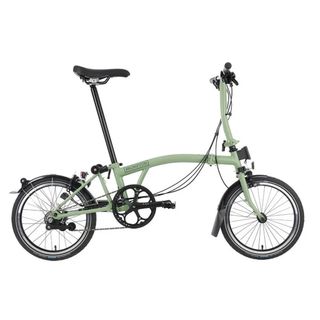
Brompton's iconic folding design is hard to beat. Its simplicity makes it easy to carry and lightweight. In our experience, Bromptons always ride really well, whether loaded or unloaded. The C-line Explore is no exception.
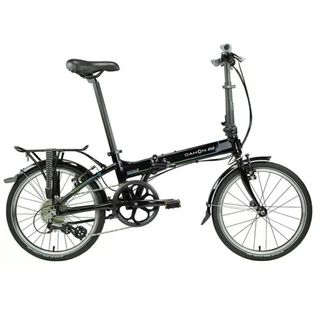
The Dahon Mariner seeks to deliver a practical folding solution without the usual high price tag. It features a quality folding mechanism, a rack, and fenders, making it commute-ready.
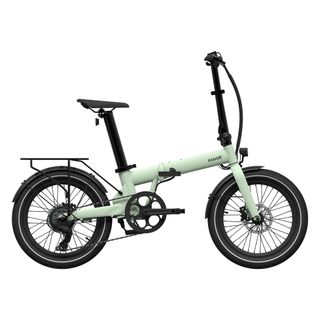
I'll take an Eovolt any day over a Brompton Electric. Its rear hub drive provides better control and lighter steering. It also has a seatpost battery, larger wheels, and is significantly cheaper.
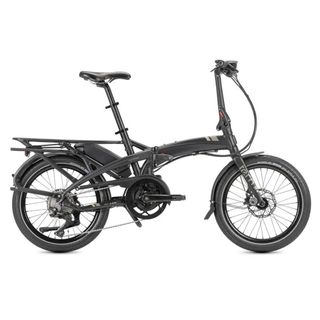
The Vektron's value is found in the quality of its components and accessories - a reliable Bosch motor and battery and fitted rack and fenders.
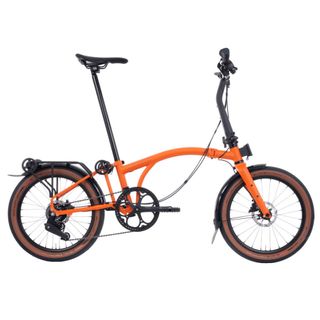
Designed around larger 20-inch wheels instead of the usual 16-inch and fitted with wide tyres, the Brompton G Line is adept at handling both road and track, making it a versatile folder indeed.

The P Line combines all the benefits of a standard Brompton with a much lower weight. Thanks to its Titanium rear frame and forks, many models in the P Line range weigh under 10kg.
Our pick of the best folding bikes
Best overall
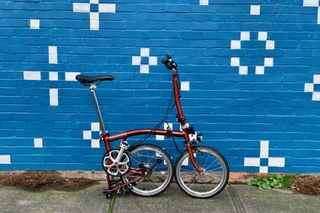
Specifications
Reasons to buy
Reasons to avoid
World-renowned, UK-based brand Brompton is the market leader in the best folding bikes. There's one frame size, with a whole range of customization options. Customers can choose everything from the handlebar shape, frame material (which obviously affects the weight), number of gears, finishing kit and, of course, colour. Brompton's feature a traditional 16in wheel size and are famously quick and easy to fold.
With six gears we found the C Line Explore, to be the ideal folding bike for tackling hilly terrain - we also appreciated the fenders that protected out clothing from mucky road spray. Furthering it's commuter credentials, there is a front luggage block that lets you clip on a Brompton specific bag, available at an additional cost, and a set of durable and puncture-resistant Schwalbe tires.
The C Line weighs just over 12kg/26lbs, which means it's not the lightest object to carry when folded up, but there are other options in Brompton's line-up if this is an issue, notably the 'featherweight' T Line.
Read our full Brompton C Line Explore review
Best budget
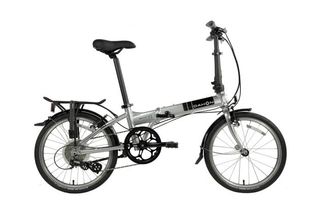
Dahon's Mariner D8 comes with a rear rack as standard
2. Dahon Mariner D8
Our expert review:
Specifications
Reasons to buy
Reasons to avoid
The Mariner D8 is on of US brand Dahon's most popular folding bikes, and with its all round performance, it's clear to see why.
The frame is made from the brand's Dalloy (an aluminium alloy) Sonus tubeset and it folds via Dahon's Lattice forged hinge with what it calls ViseGrip technology, which the brand says makes it a fast folder. It also helps keep the overall weight reasonably low. It's far from the lightest folding bike - that award goes to the Hummingbird folding bike - but at 27.69lb/12.56kg, it's far from portly.
The 20in wheels and V-brakes may be of no particular brand, but the Mariner D8 gets an eight-speed Shimano Altus drivetrain, a great reliable and durable component, and a great find at this price point.
Coming complete with a rear rack and full-coverage fenders/ mudguards, it's ready to commute or go shopping straight out the box, once you've undertaken the tricky task of assembling this website only purchase.
It's one of the best folding bikes on the market as it does tick all the boxes of what to look for in a folder, but they're just rather small ticks. In order to reach this competitive price point, you are making compromises all around, with none of the Dahon Mariner D8 features really excelling. It's not particularly exciting, thrilling or stand-out-from-the-crowd beautiful. It just does what it says, and sometimes that's all we really want.
Best electric
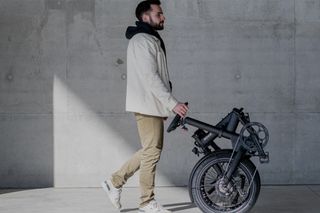
3. Eovolt Afternoon 20" Origins
Our expert review:
Specifications
Reasons to buy
Reasons to avoid
While I have never officially reviewed the Eovolt, I did test-ride a few at a local bike shop to see how they compared to the Brompton Electric. I am happy to report that it is head and shoulders above the market-leading folding bike manufacturer when you consider it as an e-bike rather than a folding bike. Brompton, of course, offers the best folding bike, but I have always thought the electric version is a little undeveloped and frantically disappointing for the price.
The rear hub drive and battery placement immediately distinguish it from the Brompton. Before I get to the rear hub, the battery placement in the seat post centres the weight, and as this is where all rider weight is, it makes little to no difference to the handling and doesn't need to be removed for folding.
In my opinion, the choice to spec a rear hub drive is a no-brainer, without getting too into the pros and cons of hub-driven electric bikes right now. A rear hub eliminates undesirable handling qualities compared to when the power goes to the front wheel. It's a simple push versus pull; push makes it easy to control, and pull makes it easier to move heavier loads. More importantly, it's just a lot safer, especially in damp conditions.
Aside from that, there is a huge cost disparity between the two, with the Eovolt nearly £1000/$1300 cheaper than the cheapest Brompton. Which is a significant chunk of cash that could go towards your railway season ticket or even a nice holiday.
Best for cargo
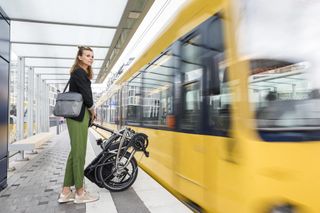
Tern's Vektron features high-end components from Shimano and Bosch
4. Tern Vektron S10
Specifications
Reasons to buy
Reasons to avoid
We really rated the non-electric Tern Verge X11, so have complete confidence that the powered Tern Vektron will also be one of the best folding bikes on the market.
This time the Vektron has slightly smaller 20-inch wheels, although these are larger than some folding bike models, like the Brompton, which are teamed with Schwalbe Big Apple tyres, and should provide a really stable and comfortable ride feel.
The biggest deal with this electric folding bike is that it features a high-quality gold standard Bosch electric drivetrain, with a full charge that can last between 30 and 60 miles depending on the level of electric assist.
The rest of this impressive folding bike is, as expected with Tern, specced highly with Magura MT4 hydraulic disc brakes and a reliable Shimano 10-speed Deore drivetrain. The as standard Atlas rack can haul 27kg/59lbs, and is also compatible with a child bike seat.
With the battery, motor rack, fenders/mudguards and integrated lights however does come a weight compromise. Weighing in at 48.72lb/22.1kg it's probably one of the heaviest folding bikes on the market, which can make off bike manoeuvrability tricky, especially if there are stairs involved.
Weight penalty aside, this is one of the best folding bikes money can buy, you'll just require rather a lot.
Best for gravel
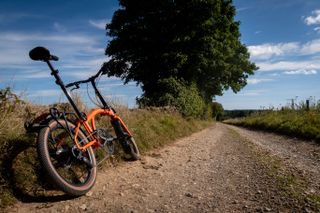
The G Line uses 20 inch wheels and wide gravel tyres to navigate varying terrain
5. Brompton G Line
Specifications
Reasons to buy
Reasons to avoid
Designed for off as well and on-road use, the G Line is built around a larger 20 inch wheel size, dressed in wide Schwalbe gravel tyres.
But the four inch increase in wheels isn’t the only difference. There are disc brakes, and hydraulic ones at that. Sensibly Brompton has also equipped the rugged G Line with Shimano’s Alfine eight-speed internal gear rear hub, which offers a 307% gear range and keeps all the drivetrain components out of harm’s way.
While still using the same folding mechanism that unites all Bromptons, the G Line has longer chain status and wheelbase, in part to accommodate the bigger wheels, but also to add more stability - a smart move given the intended use of the bike.
And, in general, it works. We found the bike was a remarkably stable place to be, with the twitchness found on the smaller-wheeled model replaced with a more assured ride. Off road the wide gear range coped with the hills, but the bike’s weight - some 15kg in the size large we tested - meant it was slow going.
We were impressed with how the wheels and tyres rolled over gravel tracks and paths, helping to absorb some of the ruts and potholes. On trickier descents the wider handlebars were greatly appreciated.
All told, it’s a clever bike that neatly bridges the urban-rural divide with aplomb.
Read our full Brompton G Line review
Best lightweight
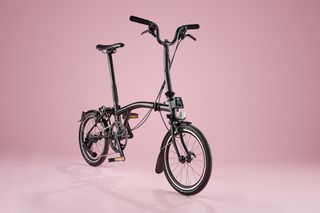
Brompton's P Line uses lightweight materials throughout
Specifications
Reasons to buy
Reasons to avoid
Brompton's P Line features a titanium rear triangle, which makes for lighter sub-10kg option to the original all steel Brompton, now called the C line, which will weigh in between 24.7 and 26.6lbs/11.2 and 12.1kg. During our testing we really noticed the difference, and while 22lbs /10kg is still a fair amount to carry around for longer periods, the reduction in weight did make the P Line altogether easier to pick up and take with us.
Like all Bromptons it's nicely put together with umpteen clever little design hacks. We really liked the saddle up, roll-ability, not offered on previous P Lines, that allowed us to easily wheel it around a station concourse via the saddle and maneuver it around commuters during the rush to the train.
The four-speed gearing system is just as clever. It comes with an ingenious own brand two-piece derailleur which has been designed to fit inside the narrow fold. We did find however that the rear derailleur was a little fiddly to adjust and we'd have liked a smaller bottom gear, but both are relatively minor issues.
All told, we found the new P Line to be more practical, more 'pickupable', more maneuverable than before, which truly makes it one of the best folding bikes out there.
Read our full Brompton P Line review
Folded Size & Weight Comparison Chart
It's very difficult to represent how different-sized folding bikes can be visually. Even if we had tested all these bikes simultaneously, getting a picture with them all in one shot would be quite wide and not offer the best perspective. However, from the data alone, you can see that Brompton stands above the rest, offering the smallest folded size and lowest weights.
It also puts into perspective how competitive the relatively affordable Dahon is. It has only half a Kilo/1.1 lbs between it and Brompton's most popular model, the C line. While it takes up more room, considering its 20-inch wheel Vs 16-inch, it is more comparable to the G line, in which the Dahon is considerably smaller.
It is worth noting the weight of the folding e-bikes. While both can be rolled on their back wheels, you will inevitably have to carry them at some point. At twenty kilos plus, that is like carrying around an average 6-year-old. Brompton doesn't fare much better here, either. While their range of Electric models starts at a much lower overall bike weight, once the motor and battery are fitted, they are still in the 17 - 18kg range.
W x H x D (cm) | Overall in m3 | Weight (kg) | |
Brompton C line | 65 x 58 x 27 | 0.10 | 12.1 |
Dahon Mariner | 65 x 32 x 79 | 0.16 | 12.6 |
Eovolt Afternoon 20" Origins | 85 x 73 x 46 | 0.28 | 20.9 |
Tern Vektron S10 | 41 x 86 x 68 | 0.23 | 22.1 |
Brompton G Line | 72 x 67 x 41 | 0.19 | 13.9 |
Brompton P Line | 65 x 58 x 27 | 0.10 | 9.9 |
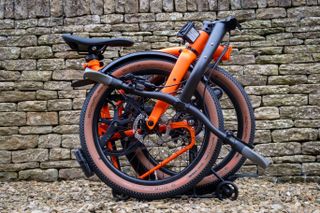
How we test
Cycling Weekly's team of testers has extensive experience assessing bikes, components, clothing, and accessories at a range of prices and specifications. Our expertise ensures a consistent and thorough perspective, which is evident in our product ratings and can be read more about on our How We Test page.
Testing folding bikes differs considerably from evaluating regular bikes. While we consider the appropriate quality and choice of components, these factors have significantly less impact on a folding bike's usability. Therefore, our experienced testers focus on other aspects that require us to test these bikes in real-world scenarios, such as hopping on trains, planes, buses, and in and out of cars, to understand which scenarios favour which bikes.
However, a considerable chunk of folding bike testing is not conducted on the bike at all. A major aspect of their convenience is their ease of storage and flexibility. This means the team spent time placing the bike in various storage scenarios, which could include the luggage compartment of a train or bus, the boot or footwell of their car, and awkward spaces behind sofas or under the stairs. We are also considering how easy the bike is to fold, whether it remains folded, its portability, and its weight.
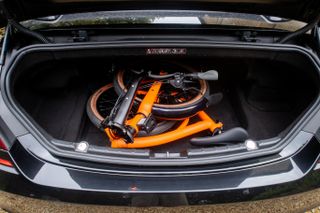
Sometimes we just take folding bikes out for a nice sunday drive
How to choose the best folding bike for you
Folding bikes really have one main function, which is to reduce the size of a bicycle so that it can be stored away, taking up minimal space. While they are incredibly versatile and offer fantastic flexibility, they truly shine when convenience is required. That’s not to say you can't ride them on epic tours or embark on crazy adventures, as many do; it’s just that this is not where they excel. Below is our list of scenarios in which we believe folding bikes can make a significant difference:
- Ease of switching between cycling and public transport
- Stores easily in your home
- Peace of mind of not having to lock up the bike outside (it can sit under your desk!)
- Convenient to take on vacation - collapsible bikes are popular with RV road trippers and some can even be packed into airline luggage
- Most are built with durability and simple maintenance as the top priority
- No need to spend money on a bike rack for your car
What to look for in a folding bike
Brands approach folding bike design in very different ways, which results in a wide array of options, but ultimately, the key differences can be found in the folding mechanism, wheel size, weight and price.
Folding mechanism: A collapsible bike can be folded in several different ways. Some styles are more user-friendly than others, so it's worth seeing a bike in person and practising folding and unfolding before you buy, particularly if you expect to unfurl the bike quickly on a train platform.
Folding bike wheel size: Models with smaller wheels are lighter and more compact when folded but don’t gather as much momentum on the road. Once the wheels are up to speed, a folding bike with larger wheels will roll much faster, but it will likely weigh more and be a little more cumbersome to load onto public transport or haul up a few flights of stairs.
Lightweight folding bikes: If you intend to hoist the bike on and off trains, it's understandable that you want it to be light. This can be achieved by using a lighter frame material. Brompton has introduced titanium to its range, and there are brands, such as Hummingbird, that make carbon folders. Higher quality components will also reduce the weight, as will opting for fewer gears - such as a single-speed version - but this will only really suit someone who doesn't expect to come across many hills in their use of the bike.
Folding bike adjustability: Most folding bikes will be ‘one size fits all’, with a great deal of adjustability – meaning that it’s easy to share the bike across members of your household. However, if you know this is an important consideration, it’s worth ensuring that the model you buy offers a wide range of adjustments that are easy to use. Brompton bikes, for example, have a long seatpost that is adjusted via a simple quick-release lever, making it easy to swap between riders.
Electric folding bikes: In recent years, electric folding bikes have gained immense popularity, especially among caravaners and RV owners. While adding a motor typically increases the overall weight, weights continue to decrease as the bikes are developed, and the added power makes ascents significantly easier.
Folding bike frame materials
As with any type of bike, there are multiple options when it comes to frame material.
Collapsible bike market leader Brompton specializes in steel – using its renowned high-quality brazing techniques to ensure that the frame welding provides the lightest yet strongest bond possible. Steel is resilient and comfortable – but it’s not the lightest and that's why Brompton started offering some titanium-tubed folders.
Aluminium is a very popular choice for its balance between weight and resilience - and also low price.
For those who really want to splash out, there are carbon-framed folding bikes such as Hummingbird's singlespeed, which comes in at 8kg. Although using carbon will make for a super-light folding bike, it's easier to damage than steel or aluminium, which is worth bearing in mind as many folders pick up a few knocks being hauled on and off trains.
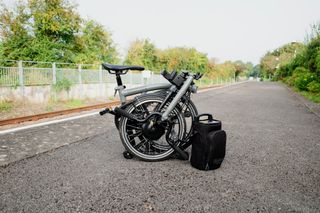
Electric folding bikes: the future?
The huge rise in popularity of e-bikes hasn't passed the folding family by. There's an increasing number of folding e-bikes, and in the next few years, we can expect to see that number grow even more.
Having an electric motor assist your folding bike means you can commute without worrying about getting sweaty in your work clothes.
Electric assist is also a perfect way of overcoming one of the drawbacks of e-bikes: their weight. They are relatively heavy in size due to the extra rigidity that has to be built into their hinged parts. So, although a folding electric bike will weigh more than a standard one, you'll get some help with your pedalling.
The lightest folding e-bike we’ve seen actually available to buy is the A-bike, at 12kg. However, most models weigh over 15kg, and over 20kg isn’t an unreasonable mass. Most feature a way to roll the bike around, either via its back wheel or an extra set of roller skate-style wheels.
As with any e-bike, have a good look at battery run times – most of the best folding electric bikes can power you for about 50 miles. So, if you're planning a mega commute, remember to take a charger or have one at both ends of your journey.
Frequently asked questions about folding bikes
Are cheap folding bikes worth it?
While the saying 'you get what you pay for' mainly applies here, you can be pleasantly surprised by a cheap folding bike. A cheap folding bike will do the job, but due to lower-end components and a heftier frame, it will be heavier than more premium offerings. For those not looking to use them on public transport, this might not be as much of a factor.
What cheap folding bikes excel at is infrequent use. Many people, when they purchase a bike that they only use in nice weather, tend to opt for one of the best hybrid bikes and then struggle to store it for the remaining 11 months of the year. If that sounds like you, then it's worth considering a folding bike instead.
What is the disadvantage of a folding bike?
The primary disadvantage of folding bikes, particularly those with smaller wheels, is their ride quality. While they perform adequately over shorter distances and are generally acceptable for most. Their limitations become apparent on open roads, where you begin to notice a significant drop in performance and lack of comfort. Not only do they demand more effort to maintain speed, but they can also feel twitchy; with such little rubber on the road, the ride can be a bit sketchy.
Why is Brompton so popular?
Despite its age—it began mass production in the 1980s—Brompton still arguably boasts the most compact and refined design. This is largely due to its ability to shorten its wheelbase, with the rear wheel folding underneath and resting under the frame.
There are certainly a number of other factors, such as the strength of the design, not only from a structural standpoint but also from an intellectual property perspective. This means it is nearly impossible to design anything similar to a Brompton without first consulting a lawyer.
The brand also enjoys the prestige of the 'handmade in Britain' stamp. As one of the few brands, let alone bike brands, that manufacture nearly everything in the UK, it serves as a sign of quality manufacturing around the world, much like Mini or Dyson.
Are all folding bikes designed for urban use?
The short answer to this is yes, and for good reason. While folding bikes are versatile, providing something more capable off-road comes with its challenges. The added strength required to endure off-road riding, often coupled with the use of small wheels, complicates matters. Offering a suitable option for off-road would inevitably increase weight, and larger wheels would diminish the compact nature of the design, making them far less versatile.
However, there are bikes that buck that trend, for example, the relatively new Brompton G line. While it is not perfect and does suffer somewhat from the issues I mentioned above, it is by far and away the best offering currently in this category.
Get The Leadout Newsletter
The latest race content, interviews, features, reviews and expert buying guides, direct to your inbox!
Michelle Arthurs-Brennan the Editor of Cycling Weekly website. An NCTJ qualified traditional journalist by trade, Michelle began her career working for local newspapers. She's worked within the cycling industry since 2012, and joined the Cycling Weekly team in 2017, having previously been Editor at Total Women's Cycling. Prior to welcoming her daughter in 2022, Michelle raced on the road, track, and in time trials, and still rides as much as she can - albeit a fair proportion indoors, for now.
- Luke FriendFreelance writer
- Matt Ischt-BarnardEcomm and Tech Writer
-
 200 skinny bike riders doing 50kph is still too much like a high-speed Where’s Wally: The case for colour-coded helmets
200 skinny bike riders doing 50kph is still too much like a high-speed Where’s Wally: The case for colour-coded helmetsWill this bright idea ever gain the recognition it deserves?
By Michael Hutchinson Published
-
 Not a typo! These Oura Gen 3 Smart Rings have up to $100 off – Get a deep dive on your health and well being with these Amazon deals
Not a typo! These Oura Gen 3 Smart Rings have up to $100 off – Get a deep dive on your health and well being with these Amazon dealsDeals The Oura Smart Rings one of the best way's to track biometrics with a focus on recovery and wellness
By Paul Brett Published
-
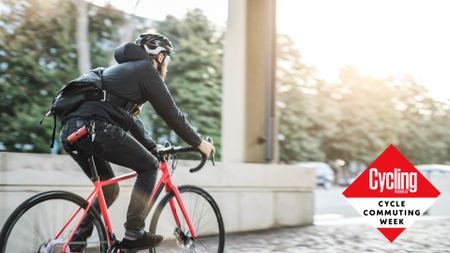 All the essentials to get started commuting by bike (on a budget – or not)
All the essentials to get started commuting by bike (on a budget – or not)Here is everything you need to buy for cycling to work – and how not to break the bank by doing so
By Stefan Abram Published
-
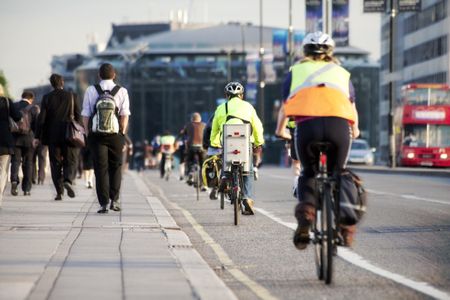 Best commuter bikes 2025: for practical cycling on a daily basis
Best commuter bikes 2025: for practical cycling on a daily basisThe best bikes for commuting to suit all styles, terrain and budgets from traffic dodging drop bar bikes to car replacement cargo bikes
By Hannah Bussey Last updated
